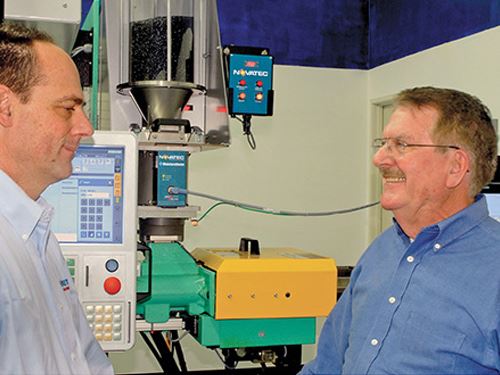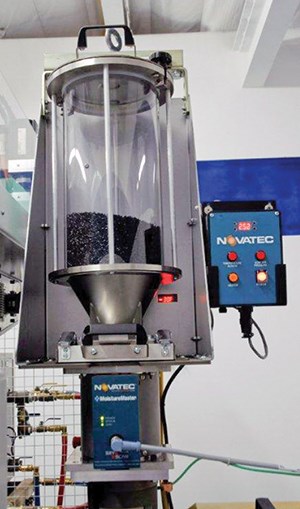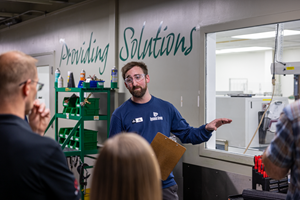New Drying Technology Helps Moldmaker Get Back to Molding
Processor Strategies: PTC Molds Co.
System solves quality problem that had hamstrung previous molder.
If you want something done right, as the old adage goes, sometimes it’s best to do it yourself. PTC Molds Co. of Arizona recently found that to be indeed the case, and in the process expanded its position in injection molding by taking on a project that another processor was having difficulty executing.
PTC, based in Scottsdale, has been in business more than 40 years, specializing in producing complex, tight-tolerance molds primarily for medical applications. It used to do a lot of custom medical molding as well, before selling off that part of the business about 15 years ago, recalls Phil Mitchell, the former owner of the company who still serves as its president. Since then, PTC’s six injection presses have been used primarily for mold validation.
Last year, PTC invested more than $250,000 to get back into the molding business. This included purchasing a new Arburg 60-ton machine that was equipped with a Novatec membrane-type dryer with a throughput capacity of 5 lb/hr, and Novatec’s MoistureMaster, a novel in-line moisture analyzer that debuted last March at the NPE2012 show in Orlando, Fla.
This about-face wasn’t what Mitchell had in mind when he built a four-cavity mold for a longstanding customer in the molding business. The PBT part, for an undisclosed medical application, is 3/8-in. long with wall thicknesses ranging from 0.006 to 0.060 in.
The trouble was, the parts kept fracturing, and the original molder, despite embarking on a stringent QC inspection program, could not determine whether bad material, a poorly designed mold, a snafu in drying, or something else altogether was causing the failures. Convinced that poor material was not the culprit, the customer sent the mold back to PTC and asked the moldmaker to prove that the tool could actually produce the parts to spec.
At first, PTC found that approximately 75% of parts were too brittle to satisfy the OEM’s requirements. At that point, Mitchell recalls, PTC got down to business, building a clean room and ordering the new press with the Novatec drying technology. After some initial testing to find the optimum moisture content of the PBT needed to make non-brittle parts consistently, PTC was able to mold parts that were virtually 100% defect-free and passed the fracture test. PTC then took over the molding job.
“We cut no corners on this project,” Mitchell states. “We look at the MoistureMaster as an ‘insurance policy’ that gives us confidence the machine is being fed material in the best condition possible.”
When PTC is ready to start molding each day, it starts up the NDM-5 membrane dryer. It produces the required 250 F process air, at a consistent -40 F dewpoint, without desiccant. After the material reaches the proper temperature and is exposed to the low-dewpoint air, the machine operator fills approximately 1 lb of resin into the MoistureMaster chamber and gets an immediate reading of the moisture content. When the moisture content gets to the required level, the material is fed to the press and molded.
Since NPE, Novatec has invested about $100,000 in its Drying Technology Center in Baltimore, adding four new offline moisture analyzers, reports Doug Arndt, drying systems engineer and MoistureMaster product manager. It has run more than 1000 validations tests of resins such as ABS, PC, ABS/PC, nylon 6, glass-filled nylon 6, PBT, and PUR.
The MoistureMaster measures the actual moisture in the resin, so processors no longer have to infer resin moisture values based solely on drying-air temperature and dewpoint. Novatec is the exclusive supplier for MoistureMaster technology in North America. The unit can be retrofitted to virtually any drying hopper, silo, material line, or machine throat.
Related Content
Medical Molder, Moldmaker Embraces Continuous Improvement
True to the adjective in its name, Dynamic Group has been characterized by constant change, activity and progress over its nearly five decades as a medical molder and moldmaker.
Read MoreIn Sustainable Packaging, the Word is ‘Monomaterial’
In both flexible and rigid packaging, the trend is to replace multimaterial laminates, coextrusions and “composites” with single-material structures, usually based on PE or PP. Nonpackaging applications are following suit.
Read MoreFormulating LLDPE/LDPE Blends For Abuse–Resistant Blown Film
A new study shows how the type and amount of LDPE in blends with LLDPE affect the processing and strength/toughness properties of blown film. Data are shown for both LDPE-rich and LLDPE-rich blends.
Read MoreUS Merchants Makes its Mark in Injection Molding
In less than a decade in injection molding, US Merchants has acquired hundreds of machines spread across facilities in California, Texas, Virginia and Arizona, with even more growth coming.
Read MoreRead Next
Measuring Pellet Moisture In the Hopper, and in Real Time
Take the guesswork out of drying with new technology.
Read MoreUnderstanding Melting in Single-Screw Extruders
You can better visualize the melting process by “flipping” the observation point so that the barrel appears to be turning clockwise around a stationary screw.
Read MoreProcessor Turns to AI to Help Keep Machines Humming
At captive processor McConkey, a new generation of artificial intelligence models, highlighted by ChatGPT, is helping it wade through the shortage of skilled labor and keep its production lines churning out good parts.
Read More














